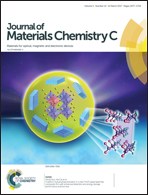Quantum spin Hall phase transitions in two-dimensional SbBi alloy films†
Abstract
Bismuth (Bi) and antimony (Sb) have similar electronic structures but distinct topological properties in their two-dimensional (2D) films, due to their different spin–orbit coupling strengths. An Sb/Bi hetero-junction is a good candidate for the formation of normal band insulator (NI)–topological insulator (TI) boundary states where dissipationless spin currents exist. However, the topological properties of 2D Bi/Sb alloy films, forming at the boundaries of their hetero-junctions, have not been well studied yet. Here, first-principles calculations are performed to study the geometric and band structures of buckled and puckered SbBi alloy 2D films. The transition point between the TI and NI phases is at x = 5 in buckled BixSb8−x and at x = 3 in puckered BixSb4−x. The topological transition of buckled SbBi can be explained using the well-known band inversion mechanism between p orbits, caused by the variation of either components or lattice parameters. According to the analysis on the SOC strength, we propose an experiential ratio rule for the topological phase transition point of SbBi, by simply comparing the number of Bi and Sb atoms, which will be useful in the designing of topological materials and devices for experiment.



 Please wait while we load your content...
Please wait while we load your content...